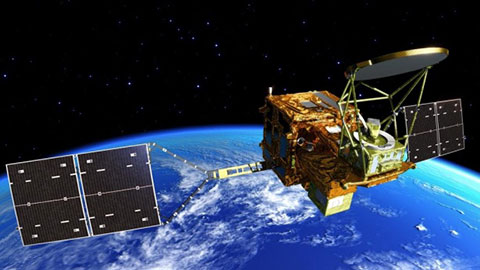SHIZUKU (GCOM-W1)
to Provide Brightness Temperature Products
Japan Aerospace Exploration Agency (JAXA)
The Japan Aerospace Exploration Agency has started offering brightness temperature products*2 from the onboard Advanced Microwave Scanning Radiometer 2 (AMSR2) of the Global Change Observation Mission 1st - Water "SHIZUKU" (GCOM-W1), after its initial calibration operation*1 was completed. The SHIZUKU was launched on May 18, 2012.
JAXA processed the original raw data acquired by the SHIZUKU with correction to reveal brightness products this time. The products are expected to be widely used not only by domestic researchers and institutions concerning meteorology and weather changes including the Japan Meteorological Agency and other private weather forecasters, but also overseas meteorological institutions such as the National Oceanic and Atmospheric Administration (NOAA) of the United States.
We will further compile eight physical quantity products of the Earth namely accumulated vapor volume, accumulated cloud liquid water contents, precipitation, ocean surface temperature, ocean surface wind velocity, sea ice concentration, snow depth, and soil moisture. We are now comparing SHIZUKU's data and ground observation data to be ready to offer such products in May this year, a year after the SHIZUKU's launch.
[How to receive data]
Please register at the following SHIZUKU data provision website:
https://gcom-w1.jaxa.jp
After registering, you can download brightness temperature products.
*1 Calibration operation: To improve measurement accuracy (brightness temperature accuracy), data acquired by an observation device (the AMSR2 in the case of the SHIZUKU) is evaluated, then the device as well as data processing software on the ground are checked and corrected if necessary.
*2 Brightness temperature indicates the radio wave strength of a specific frequency emitted from the atmosphere and the ground.

For more about the SHIZUKU, please refer to the following JAXA Space Application Mission Directorate website:
http://www.jaxa.jp/projects/sat/gcom_w/index_e.html
|
|
Attachments: Products of SHIZUKU AMSR2
(1) Brightness temperature productsThe AMSR2 measures the strength of microwaves in six frequencies between 7 GHz and 89 GHz emitted from the ground and the atmosphere. In the 7 GHz bandwidth, the AMSR2 has two receiver systems for the frequencies of 6.925 GHz and 7.3 GHz, and it is also equipped with two receiver system called system A and B in the 89 GHz bandwidth. Each frequency/system can measure vertical polarization and horizontal polarization, thus the AMSR2 can offer 16 different kinds of brightness temperature products. The following Chart 1 is the AMSR2's major characteristics, and Figure 1 shows some examples of brightness temperature products.
Chart 1: AMSR2 Major Characteristics
| Observation frequency (GHz) | 6.925 | 7.3 | 10.65 | 18.7 | 23.8 | 36.5 | 89.0(A) | 89.0(B) |
| Observation polarization | Vertical and horizontal polarizations | |||||||
| Measuring range (K) | 2.7 - 340 | |||||||
| Temperature resolution (K) | 0.34 | 0.43 | 0.7 | 0.7 | 0.6 | 0.7 | 1.2 | 1.2 |
| Instantaneous view angle (Az×El) | 35×62 | 34×58 | 24×42 | 14×22 | 15×26 | 7×12 | 3×5 | 3×5 |
| Measurement width (km) | 1450 | |||||||

Figure 1: Examples of Brightness Temperature Products (on ascending orbit on Jan. 18, 2013)
(2) Physical quantity products of the Earth
Some brightness temperature in a certain frequency differs according to physical objects and conditions of the ground and the atmosphere where radio waves are emitted. Thus, we can calculate physical quantity of the Earth such as ocean surface temperature by combining brightness temperature information in several frequencies. Figure 2 below indicates which brightness temperature products generated by the AMSR2 are used for which of eight Earth physical quantity products (accumulated vapor volume, accumulated cloud liquid water contents, precipitation, ocean surface temperature, ocean surface wind velocity, sea ice concentration, snow depth, and soil moisture.) For example, a 6.925 GHz brightness temperature product that is sensitive to the ocean's surface is mainly used for finding such a temperature while correcting the impact of atmospheric vapor using 23.8 GHz and 36.5 GHz brightness temperature products.
The earth physical quantity products acquired by the SHIZUKU are currently under the evaluation process of comparing them with the products measured by other observation methods on the ground including a radiosonde and ocean buoy. We plan to start offering earth physical quantity products in May this year, a year after the launch of the SHIZUKU.
The products are expected to be useful in various areas such as compiling information on fishing conditions for understanding fishery activities, studying draughts and floods, for application in the agriculture sector, and monitoring North Pole sea ice.

Figure 2: Relation between AMSR2 Brightness Temperature Products (6.925 - 89.0GHz) and Earth Physical Quantity Products

Figure 3: Examples of Earth Physical Quantity Products (on ascending orbit on Jan. 18, 2013)
You can take a look at unevaluated images on the JAXA Earth Observation and Research Center (EORC) website:
http://suzaku.eorc.jaxa.jp/GCOM_W/JASMES_daily